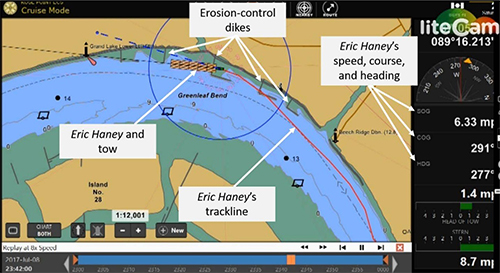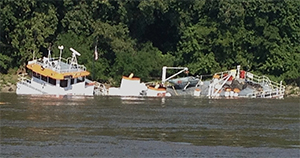Eric Haney was upbound on the Mississippi River with 15 empty barges when it slammed into an erosion-control dike near Cairo, Ill., went adrift in the current and partially sank several miles downriver.
The pilot conning the 52-year-old vessel told investigators he never spotted the charted dike on the electronic chart system (ECS) or visually from the wheelhouse. He also acknowledged an upcoming meeting with a downbound vessel was on his mind, according to the National Transportation Safety Board (NTSB).
The grounding happened shortly before midnight on July 8, 2017, at mile marker 13.4 on the Upper Mississippi River. All nine crewmembers escaped onto a barge just after the grounding. They were later rescued by a good Samaritan tug. Salvage crews raised Eric Haney, which required $4.3 million in repairs.
The NTSB determined the dikes were visible at the three-mile ECS setting the pilot used before the incident. The agency cited the pilot’s failure to identify the charted hazard as the primary cause in the accident.
The unidentified pilot had about 50 years of experience working in the towing industry but was on his first voyage aboard Eric Haney. He later told investigators he had enough time to get acclimated to the vessel. The pilot also transited the section of the river where the accident happened a month before.
Tennessee Valley Towing of Paducah, Ky., acquired the 5,000-hp Eric Haney a few months before the incident from Ingram Barge Co. of Nashville, Tenn.
According to the NTSB, the pilot relieved the captain about an hour before the grounding. Soon afterward, the tow held up on the right descending bank south of Greenleaf Bend to allow a southbound vessel to pass, then moved to the left descending bank a mile or so upriver to make way for another downbound towboat.
 |
|
A screenshot of the ECS display at a two-mile scale shows Eric Haney seconds before the towboat struck an erosion-control dike on the Upper Mississippi River near Cairo, Ill. |
|
Courtesy NTSB/U.S. Coast Guard |
The pilot made arrangements for a port-to-port meeting with the downbound riverboat Queen of the Mississippi at the top of Greenleaf Bend. As he moved toward the left bank, the towboat approached a series of erosion control dikes built in the bend to reduce current speeds. The dikes are not lit and do not show up on radar.
The vessel was traveling about 6 mph when it hit the dike and abruptly stopped. At that time the pilot thought the towboat was about 100 feet from shore.
“He stopped the engines and then put them in reverse, but the vessel would not move,” the NTSB report said.
The captain came to the wheelhouse and zoomed in on the ECS to enlarge the details on the screen. “The pilot stated that they zoomed in the display ‘way down from three miles so we could see the dikes,’ yet added, ‘I don’t know if it was too bright or I didn’t pay attention to them, but I didn’t see those dikes,” according to the NTSB report.
The vessel was breached, and pumps could not keep up with the water ingress in a forward hold. After notifying the Coast Guard, the crew stepped off the towboat onto one of the barges. According to the NTSB, the current pushed the entire tow off the dike and carried it downriver for more than an hour until an assist tug arrived.
Crew then escaped to that vessel, which also pushed Eric Haney against the right bank where it partially sank. Salvage crews raised it two weeks later and found punctures to the bow and transverse bottom plates. None of the barges were damaged.
Investigators acknowledged that the pilot “was dealing with several issues as he approached Greenleaf Bend,” including his tow’s reduced speed, an opposing 3-mph current, approaching vessels, shallow water and the bend itself. While navigating, he watched the ECS, radar and scenery outside but never saw the dikes.
Had he known about them or spotted them beforehand, the pilot told investigators, he would have steered toward the center of the river.
Tennessee Valley Towing declined to comment on the findings of the safety board investigators.

